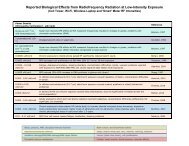Evidence for Effects on Neurology and Behavior - BioInitiative Report
Evidence for Effects on Neurology and Behavior - BioInitiative Report
Evidence for Effects on Neurology and Behavior - BioInitiative Report
Create successful ePaper yourself
Turn your PDF publications into a flip-book with our unique Google optimized e-Paper software.
D'Andrea et al. [1979, 1980] reported decreased motor activity <strong>on</strong> a stabilimetric plat<str<strong>on</strong>g>for</str<strong>on</strong>g>m<br />
<strong>and</strong> no significant change in running wheel activity measured overnight in rats exposed to 2450-<br />
MHz RFR (5 mW/cm 2 , SAR 1.2 W/kg). However, an increase in both measurements was<br />
observed in rats exposed to 915-MHz RFR (5 mW/cm 2 , SAR 2.5 W/kg). These changes in<br />
locomotor activity could be due to the thermal effect of RFR.<br />
In a more recent experiment, Mitchell et al. [1988] studied several behavioral resp<strong>on</strong>ses in<br />
rats after 7 h of exposure to c<strong>on</strong>tinuous-wave 2450-MHz RFR (10 mW/cm 2 , average SAR 2.7<br />
W/kg). Decreases in motor activity <strong>and</strong> resp<strong>on</strong>siveness (startle) to loud noise (8 kHz, 100 dB)<br />
were observed immediately after exposure. The rats were then trained to per<str<strong>on</strong>g>for</str<strong>on</strong>g>m a passive<br />
avoidance task <strong>and</strong> tested <str<strong>on</strong>g>for</str<strong>on</strong>g> retenti<strong>on</strong> of the learning <strong>on</strong>e week later. There was no significant<br />
difference in retenti<strong>on</strong> between the RFR-exposed <strong>and</strong> sham-exposed animals. The authors<br />
c<strong>on</strong>cluded that RFR altered resp<strong>on</strong>siveness to novel envir<strong>on</strong>mental stimuli in the rat.<br />
Two studies investigated the effects of pre- <strong>and</strong> postnatal-RFR <strong>on</strong> behavior. Kaplan et al.<br />
[1982] exposed groups of pregnant squirrel m<strong>on</strong>keys starting at the sec<strong>on</strong>d trimester of<br />
pregnancy to 2450-MHz RFR at SARs of 0, 0.034, 0.34, <strong>and</strong> 3.4 W/kg (3 h/day, 5 days/week).<br />
The motor activity of the m<strong>on</strong>keys was observed at different times during the third trimester. No<br />
significant difference was observed am<strong>on</strong>g the different exposure groups. After birth, some dams<br />
<strong>and</strong> ne<strong>on</strong>ates were exposed <str<strong>on</strong>g>for</str<strong>on</strong>g> 6 m<strong>on</strong>ths at the same prenatal c<strong>on</strong>diti<strong>on</strong>s <strong>and</strong> then the offspring<br />
were exposed <str<strong>on</strong>g>for</str<strong>on</strong>g> another 6 m<strong>on</strong>ths. <strong>Behavior</strong> of the mothers <strong>and</strong> offspring was observed <strong>and</strong><br />
scored each week <str<strong>on</strong>g>for</str<strong>on</strong>g> the first 24 weeks postpartum. The authors observed no significant<br />
difference in maternal behavior or the general activity of the offspring am<strong>on</strong>g the different<br />
exposure groups. Visual-evoked EEG changes in the occipital regi<strong>on</strong> of the skull of the<br />
offspring were also studied at 6, 9, <strong>and</strong> 12 m<strong>on</strong>ths of age. No significant effect of perinatal RFRexposure<br />
was reported.<br />
In another study [Galvin et al., 1986], rats were exposed to 2450-MHz RFR (10 mW/cm 2 ,<br />
3 h/day) either prenatally (days 5-20 of gestati<strong>on</strong>, whole body SAR estimated to be 2-4 W/kg) or<br />
perinatally (prenatally <strong>and</strong> <strong>on</strong> days 2-20 postnatally, whole body SARs 16.5-5.5 W/kg). Several<br />
behaviors including motor behavior, startle to acoustic <strong>and</strong> air-puff stimuli, <str<strong>on</strong>g>for</str<strong>on</strong>g>e- <strong>and</strong> hind-limb<br />
grip strength, negative geotaxis, reacti<strong>on</strong> to thermal stimulati<strong>on</strong>, <strong>and</strong> swimming endurance were<br />
studied in the rats at various times postnatally. They reported a decrease in swimming endurance<br />
(time remaining afloat in 20 o C water with a weight clipped to the tail) in 30-day old perinatallyexposed<br />
rats. The air-puff startle resp<strong>on</strong>se was enhanced in magnitude in the prenatally exposed<br />
rats at 30 days, but decreased at 100 days of age. The authors c<strong>on</strong>cluded that perinatal exposure<br />
to RFR altered the endurance <strong>and</strong> gross motor activity in the rat. It would be interesting to study<br />
the neurochemistry or brain morphology of these animals. As described in a previous secti<strong>on</strong>,<br />
Albert et al. [1981a,b] <strong>and</strong> Albert <strong>and</strong> Sherif [1988] observed morphological changes in the<br />
cerebellum of rats subjected to RFR exposure perinatally at lower SAR (2-3 W/kg). It is well<br />
known that interference of cerebellar maturati<strong>on</strong> can affect an animal's motor development<br />
[Altman, 1975].<br />
O'C<strong>on</strong>nor [1988] exposed pregnant rats to c<strong>on</strong>tinuous-wave 2450-MHz (27-30 mW/cm 2 )<br />
RFR between day 1 to day 18 or 19 of gestati<strong>on</strong> (6 h/day). Their offspring were studied at<br />
different ages. She reported no significant effect of prenatal RFR exposure <strong>on</strong> visual cliff test,<br />
open field behavior, climbing behavior <strong>on</strong> an inclined plane, <strong>and</strong> avoidance behavior in a<br />
shuttlebox. The exposed animals showed altered sensitivity to thermally related tests evidenced<br />
by preference <str<strong>on</strong>g>for</str<strong>on</strong>g> the cooler secti<strong>on</strong> of a temperature-gradient alley way, l<strong>on</strong>ger latency to<br />
develop thermally induced seizure, <strong>and</strong> <str<strong>on</strong>g>for</str<strong>on</strong>g>med smaller huddle groups at 5 days of age.<br />
52



